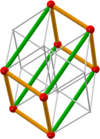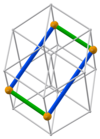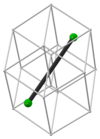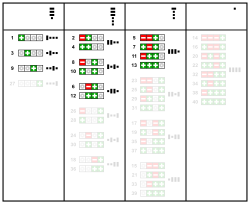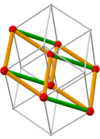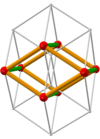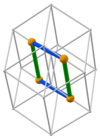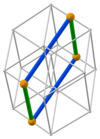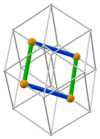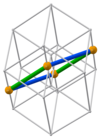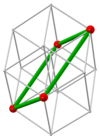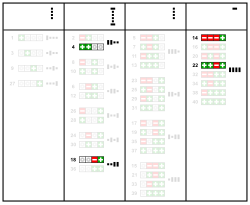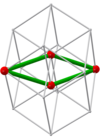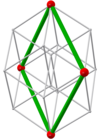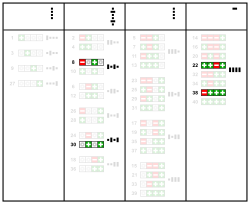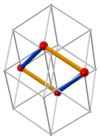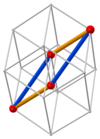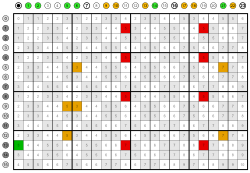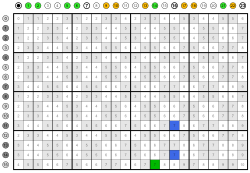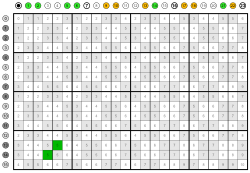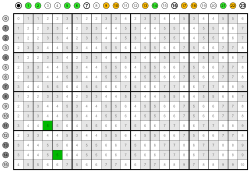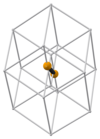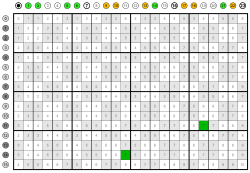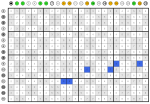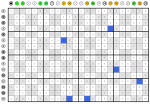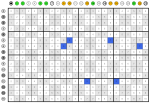Category:Tesseract subspaces (image set)


These are the sets of fixed points of permutations of the tesseract,
i.e. mainly its equivalents of symmetry axes and mirror planes,
which have 1, 2, and 3 dimensions
(plus the origin and the whole space as least and greatest elements).
Their total number is 116. That is entry 4 of ![]() A007405, the Dowling numbers.
A007405, the Dowling numbers.
Their number by dimension is row 4 of ![]() A039755, the B-analogs of Stirling numbers of the second kind.
A039755, the B-analogs of Stirling numbers of the second kind.
| 4-dim. | 1 | 1 |
| 3-dim. | 4, 12 | 16 |
| 2-dim. | 6, 24, 12, 16 | 58 |
| 1-dim. | 4, 12, 16, 8 | 40 |
| 0-dim. | 1 | 1 |
| 116 | ||
| Permutations corresponding to the 12 types of subspaces | |||||||||||||||||||||||||||||||||||
|---|---|---|---|---|---|---|---|---|---|---|---|---|---|---|---|---|---|---|---|---|---|---|---|---|---|---|---|---|---|---|---|---|---|---|---|
|
It can be seen, that the permutations have the same parity as the dimension of the subspace. | |||||||||||||||||||||||||||||||||||
| |||||||||||||||||||||||||||||||||||
Overview edit
Nested in the following collapsible tables are projections of all 116 subspaces together with a list of the positive face centers they contain.
The balanced ternary coordinates suggest a tesseract with ±1 vertex coordinates, i.e. with edge length 2.
Anyway, the lengths mentioned below refer to a tesseract with edge length 1.
Each subspace is the set of fixed points of at least one permutation. If there is more than one, they are shown in a 16×24 matrix.
76 subspaces of 9 types have a unique self-inverse permutation.
The pair of this permutation is shown next to the projection of the subspace.
The self-inverse permutation is unique (e.g. a 180° rotation), but there can be other permutations with the same set of fixed points (e.g. two 90° rotations).
4-dimensional edit

|

|
The tesseract contains all of the 81 face centers. |
(4, 12, 16, 8): [ (1, 3, 9, 27, 2, 4, 8, 10, 6, 12, 26, 28, 24, 30, 18, 36, 5, 7, 11, 13, 23, 25, 29, 31, 17, 19, 35, 37, 15, 21, 33, 39, 14, 16, 20, 22, 32, 34, 38, 40) ]
3-dimensional edit
| 3b 12 cuboids with edge lengths (orange) and (green) | ||||||||||||||||||||||||||||||||||||||||||||||||
|---|---|---|---|---|---|---|---|---|---|---|---|---|---|---|---|---|---|---|---|---|---|---|---|---|---|---|---|---|---|---|---|---|---|---|---|---|---|---|---|---|---|---|---|---|---|---|---|---|
| ||||||||||||||||||||||||||||||||||||||||||||||||
2-dimensional edit
| 2a 6 squares with edge length (blue) | ||||||||||||||||||||||||||||||||||||||||||||
|---|---|---|---|---|---|---|---|---|---|---|---|---|---|---|---|---|---|---|---|---|---|---|---|---|---|---|---|---|---|---|---|---|---|---|---|---|---|---|---|---|---|---|---|---|
| ||||||||||||||||||||||||||||||||||||||||||||
| 2b 24 rectangles with edge lengths (green) and (blue) | ||||||||||||||||||||||||||||||||||||||||||||||||||||||||||||||||||||||||||||||||||
|---|---|---|---|---|---|---|---|---|---|---|---|---|---|---|---|---|---|---|---|---|---|---|---|---|---|---|---|---|---|---|---|---|---|---|---|---|---|---|---|---|---|---|---|---|---|---|---|---|---|---|---|---|---|---|---|---|---|---|---|---|---|---|---|---|---|---|---|---|---|---|---|---|---|---|---|---|---|---|---|---|---|---|
| ||||||||||||||||||||||||||||||||||||||||||||||||||||||||||||||||||||||||||||||||||
| 2c 12 squares with edge length (green) | ||||||||||||||||||||||||||||||||||||||||||||||||||||||||
|---|---|---|---|---|---|---|---|---|---|---|---|---|---|---|---|---|---|---|---|---|---|---|---|---|---|---|---|---|---|---|---|---|---|---|---|---|---|---|---|---|---|---|---|---|---|---|---|---|---|---|---|---|---|---|---|---|
| ||||||||||||||||||||||||||||||||||||||||||||||||||||||||
| 2d 16 rectangles with edge lengths (orange) and (blue) | ||||||||||||||||||||||||||||||||||||||||||||||||||||||||||||||||||||||||||||||||||||||||||||||||||||||||||
|---|---|---|---|---|---|---|---|---|---|---|---|---|---|---|---|---|---|---|---|---|---|---|---|---|---|---|---|---|---|---|---|---|---|---|---|---|---|---|---|---|---|---|---|---|---|---|---|---|---|---|---|---|---|---|---|---|---|---|---|---|---|---|---|---|---|---|---|---|---|---|---|---|---|---|---|---|---|---|---|---|---|---|---|---|---|---|---|---|---|---|---|---|---|---|---|---|---|---|---|---|---|---|---|---|---|---|
| ||||||||||||||||||||||||||||||||||||||||||||||||||||||||||||||||||||||||||||||||||||||||||||||||||||||||||
1-dimensional edit
| 1a 4 line segments with edge length (between opposite blue points) | |||||||||||
|---|---|---|---|---|---|---|---|---|---|---|---|
| |||||||||||
 0 |
 1 |
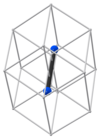 2 |
 3 | ||||||||
| |||||||||||
| 1b 12 line segments with edge length (between opposite green points) | ||||||||||||||||||||||||||||||||||||||||||||
|---|---|---|---|---|---|---|---|---|---|---|---|---|---|---|---|---|---|---|---|---|---|---|---|---|---|---|---|---|---|---|---|---|---|---|---|---|---|---|---|---|---|---|---|---|
| ||||||||||||||||||||||||||||||||||||||||||||
| 1c 16 line segments with edge length (between opposite yellow points) | ||||||||||||||||||||||||||||||||||||||||||||||||||||||||||||||||||||||||||
|---|---|---|---|---|---|---|---|---|---|---|---|---|---|---|---|---|---|---|---|---|---|---|---|---|---|---|---|---|---|---|---|---|---|---|---|---|---|---|---|---|---|---|---|---|---|---|---|---|---|---|---|---|---|---|---|---|---|---|---|---|---|---|---|---|---|---|---|---|---|---|---|---|---|---|
| ||||||||||||||||||||||||||||||||||||||||||||||||||||||||||||||||||||||||||
| 1d 8 line segments with edge length (between opposite red points) | |||||||||||||||||||||||
|---|---|---|---|---|---|---|---|---|---|---|---|---|---|---|---|---|---|---|---|---|---|---|---|
| |||||||||||||||||||||||
 0 |
 1 |
 2 |
 3 |
 4 |
 5 |
 6 |
 7 | ||||||||||||||||
| |||||||||||||||||||||||
0-dimensional edit


|
The origin has the coordinate |
(0, 0, 0, 0): [ () ]
Numbering edit
The numbers used in the filename refer to the the colexicographic ordering of the positive vertices.
This allows to use the same identifiers for all dimensions.
(E.g. cube subspace 2b5 and tesseract subspace 2b05 are the same rectangle with vertices 11 and 13.)
But it is more intuitive to use lexicographic order that takes all face centers into account. (It allows sorting by patterns like 1000.)
The following table shows the lexicographic order of the four kinds of subspaces where the orders differ.
(compare code)
| 3b | 0, 11, 1, 10, 3, 8, 2, 9, 4, 7, 5, 6 |
|---|---|
| 2b | 0, 5, 6, 11, 12, 17, 1, 4, 7, 10, 18, 23, 2, 3, 13, 16, 19, 22, 8, 9, 14, 15, 20, 21 |
| 2c | 3, 6, 5, 9, 2, 4, 7, 10, 0, 1, 8, 11 |
| 2d | 0, 3, 8, 15, 1, 2, 11, 14, 4, 6, 10, 13, 5, 7, 9, 12 |
Code edit
These images have been rendered with POV-Ray, and the calculations have been done with Python.
The code can be found on GitHub.
The main POV-Ray file is subspaces.pov.
The colored code sections shown above are from the dictionary in e1_store_subspaces.py.
Subcategories
This category has the following 4 subcategories, out of 4 total.
T
Pages in category "Tesseract subspaces (image set)"
The following 4 pages are in this category, out of 4 total.



















